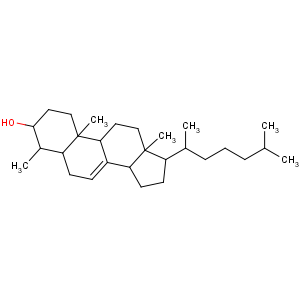Title: Gum Tragacanth
CAS Registry Number: 9000-65-1
Synonyms: Tragacanth
Literature References: Mol wt about 840,000. The dried gummy exudation from
Astragalus gummifer Labill. (white gavan) or other Asiatic species of
Astragalus, Leguminosae, found largely in Iran, also in Asia Minor and in Syria. When mixed with water gives a soluble fraction, as a hydrosol, called
tragacanthin which is a complex mixture of polysaccharides containing D-galacturonic acid, other sugars, and traces of starch and cellulose. The insoluble fraction swells to a gel and consists of 60-70% bassorin. Structural studies: Norman,
Biochem. J. 25, 200 (1931); James, Smith,
J. Chem. Soc. 1945, 739, 749; Aspinall, Baillie,
ibid. 1963, 1702, 1714.
Reviews: D. C. Beach in
Adv. Chem. Ser. 11, entitled "Natural Plant Hydrocolloids," (ACS, Washington DC, 1954) pp 38-44; Meer
et al. in
Industrial Gums, R. L. Whistler, Ed. (Academic Press, New York, 2nd ed., 1973) pp 289-299.
Book: F. Smith, R. Montgomery,
The Chemistry of Plant Gums and Mucilages (Reinhold, New York, 1959) 627 pp.
Properties: Odorless. Insipid, mucilaginous taste. Acid reaction. One gram requires 0.9 ml 0.1
N NaOH for neutralization to phenolphthalein: Gabel,
J. Am. Pharm. Assoc. 23, 341 (1934). Viscosity of tragacanth mucilages is reduced by adding acid, alkali, and NaCl particularly if the mucilage is heated: Mantell,
The Water-Soluble Gums (New York, 1947). Maximum initial viscosity of solns at pH 8; maximum stable viscosity near pH 5. Forms a deep yellow stringy precipitate when a soln is boiled with a few drops of 10% aqueous ferric chloride soln. A stringy precipitate formed also on heating a soln with Schweitzer reagent. Tragacanth is entirely insol in alcohol.
Use: In pharmaceutical compounding and dispensing,
e.g., to suspend heavy insol powders, as an excipient for tablets and to impart consistence to troches; also in making emulsions and emulsifying agents; as stabilizer, thickener, texturizer in food; in adhesives (mucilages, pastes); in textile sizing, textile printing and general printing inks, and in dyeing with insol color lakes.

